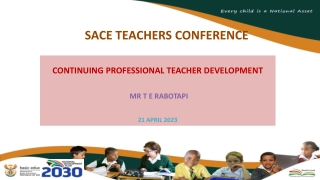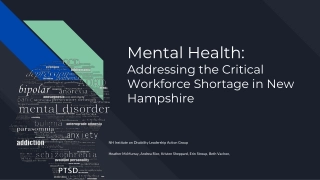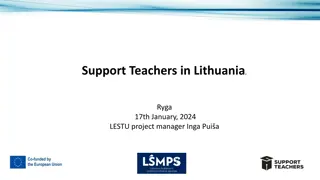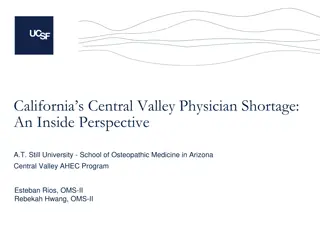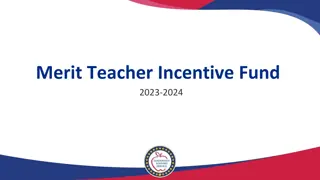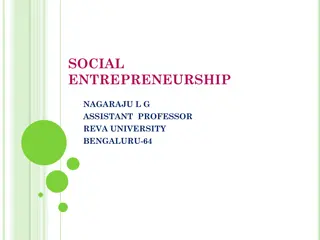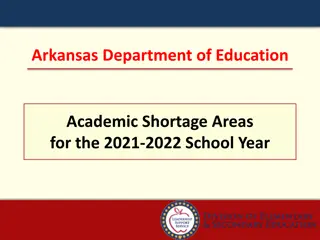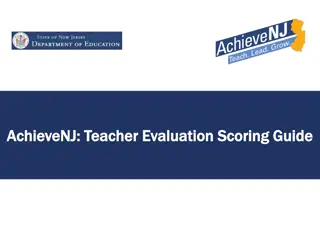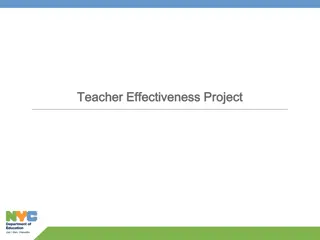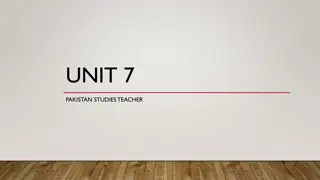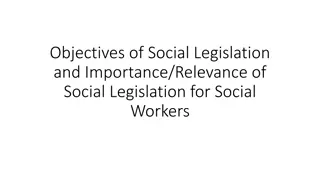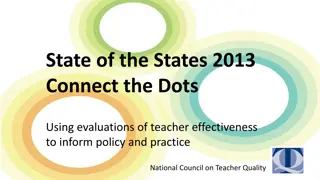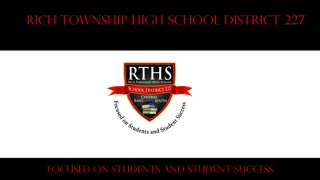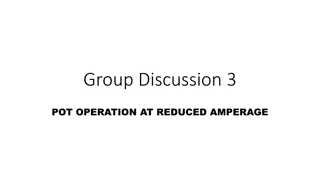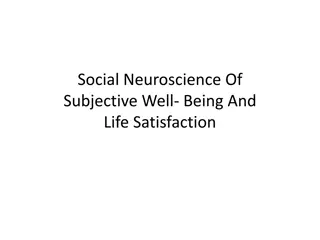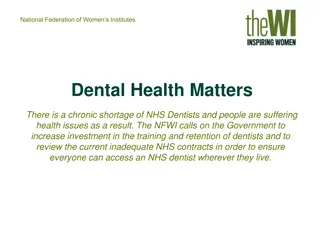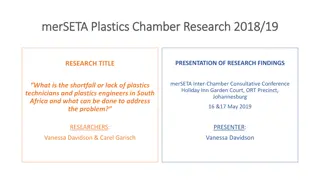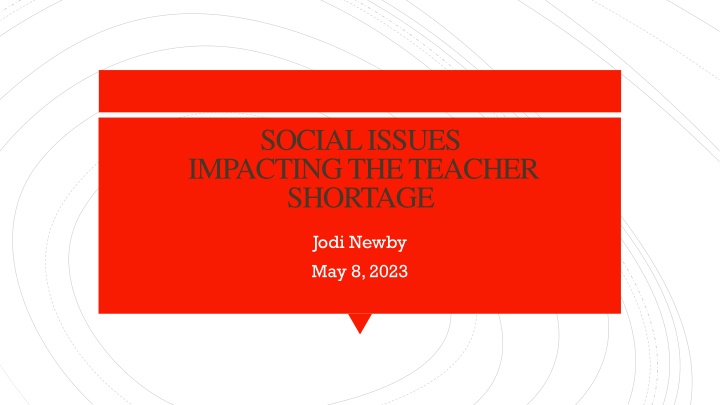
Addressing Teacher Shortages Through Social Issue Awareness
Explore the impact of social issues on the teacher shortage crisis, including mental health challenges, anti-LGBTQ legislation, and disparities affecting retention. Discover the problems, solutions, and potential strategies to combat these obstacles and support educators effectively.
Download Presentation

Please find below an Image/Link to download the presentation.
The content on the website is provided AS IS for your information and personal use only. It may not be sold, licensed, or shared on other websites without obtaining consent from the author. If you encounter any issues during the download, it is possible that the publisher has removed the file from their server.
You are allowed to download the files provided on this website for personal or commercial use, subject to the condition that they are used lawfully. All files are the property of their respective owners.
The content on the website is provided AS IS for your information and personal use only. It may not be sold, licensed, or shared on other websites without obtaining consent from the author.
E N D
Presentation Transcript
SOCIAL ISSUES IMPACTING THE TEACHER SHORTAGE Jodi Newby May 8, 2023
Growing, worldwide problem In US 2018 approximately half actively looking 53% looking for new profession nationwide core subject shortages Indiana 2022 95% districts report shortages 60% science shortages 58% math shortages 91% emergency licenses 55% teachers outside licensed area 37% fulltime subs covering positions The Teacher Shortage Expected job growth 2020 to 2030 5% per year 77,900 positions per year
Portage Township Schools Teacher Shortage and Retention survey 196 responses out of 407 teachers
ISSUES TO BE ADDRESSED ISSUES TO BE ADDRESSED Problems and Solutions Problems and Solutions Mental Health and Burnout Anti-LGBTQ Legislation Racial Disparities with Teachers and Students Gendered Imbalance of Invisible Labor
MENTAL HEALTH AND THE TEACHER SHORTAGE: The Problem Burnout vs. demoralization Depression more common with teachers Mental health and retention Teacher/student mental health US DOE teacher mental health major issue of concern Educational crisis that impedes learning Since COVID 27% increase in clinical depression 37% increase in anxiety disorders 19% increase in alcohol consumption Stress-caused disability and missed work
MENTAL HEALTH AND THE TEACHER SHORTAGE: Possible Solutions Populations most affected Womenand Teachers of color Low pay- Indiana ranks last Districts- be intentional with mental health SEL interventions Teaching performance vs. intrapersonal development Insurance policies- mental health services Promote physical activity 2 times per week Early burnout education and intervention 10% leave year 1 12% more year 2 40-50% leave by year 5 Administrators- know signs of teacher burnout
Portage Township Schools
ANTI-LGBTQ LEGISLATION AND THE TEACHER SHORTAGE: The Problem Don t Say Gay and No Promo Homo (NPH) Fear legal repercussions Laws at odds with personal values Children as young as preschool: Boys- gendered power over girls bodies Sense of heteronormativity Rules of sexuality Silence not neutral Indiana HB 1608 Up to 3rd grade All grades Florida HB1557- Dangerously vague Teachers petrified - fired, fined, or jailed LGBTQ teachers and allies
ANTI-LGBTQ LEGISLATION AND THE TEACHER SHORTAGE: Possible Solutions ACLU prepares lawsuits in many states Tinker vs. Des Moines Independent School District Neutrality teaches heterosexuality good, anything else bad Harm of LGBTQ youth not being represented School districts should be proactive Establish a district stance Establish clear-cut policies and procedures
Portage Township Schools If legislation were passed in Indiana which could possibly result in teachers being sued or fired for Using student s chosen pronouns without consent Not informing parent of child s sexual orientation Refusing to remove pictures of same-sex spouse Refusing to remove LGBTQ safe space stickers or rainbow flags from classroom How would this impact your decision to remain a classroom teacher?
TEACHER-STUDENT RACIAL DISPARITY AND THE TEACHER SHORTAGE: The Problem All racial groups, greatest with Black population Post-Brown vs. Board of Ed Black teachers not hired by White admins Black teachers- $2,700 less per year than Whites $52K college debt vs. $25K for Whites Steered toward high minority schools Fewer Black students choose teaching No role models Negative association with school Lack of confidence in academic ability Black applicants less likely to secure teaching position <50% of Black teachers received job offers 77% of White teachers received job offers
RACIAL DISPARITY continued Black children with just 1 black teacher in grades 3-5 Boys less likely to drop out Boys and girls more likely to go to college Only slight difference between 1 Black teacher and 2 or more Score higher on standardized tests Stereotype threat White teachers- lower expectations for Black students White teachers- judge Black students more Students of all races benefit
TEACHER-STUDENT RACIAL DISPARITY AND THE TEACHER SHORTAGE: Possible Solutions Name discrimination in the hiring process Black-sounding names vs. White-sounding names- 50% fewer callbacks Implicit bias training Clear and explicit nondiscrimination and harassment policies Remove names and addresses from applications Multiple interviewers with diverse backgrounds Teacher professional development on implicit and unconscious bias Encourage Black students to enter Teaching Vocational
Portage Township Schools
407 Teachers Race 390 White 8 Black or African American 5 Asian 3 American Indian or Alaskan 1 Hawaiian or Pacific Islander Portage Township Schools Ethnicity 378 Not Hispanic or Latino 29 Hispanic or Latino
Portage Township Schools US News & World Report, 2022
Race of Teachers Portage Indiana White Black Other 0.9 95.8 1.9 4 93 3 Race of Students White Black Ethnicity of Teachers Hispanic or Latino Not Hispanic or Latino Portage vs. Indiana Demographics 53.2 66.4 15.7 12.7 7.1 92.8 1.7 98.3 Ethnicity of Students Hispanic or Latino Not Hispanic or Latino 24.3 75.7 12.8 87.2
GENDERED IMBALANCE OF INVISIBLE LABOR AND THE TEACHER SHORTAGE: The Problem Invisible labor Emotional labor Female faculty more likely Societal expectations Black women- more disproportionate Motherhood imagery Ubiquitous across cultures and nations Necessary tasks and activities- no compensation or advancement Surface Acting vs. Deep Acting Negative mental and physical health outcomes 40% consider leaving job due to chronic exhaustion or stress
GENDERED IMBALANCE OF INVISIBLE LABOR continued Women work harder for advancement than men Hallway Asks Women- 200 hours more invisible work per year Women volunteer Women are asked to volunteer Women judged harshly for not volunteering
GENDERED IMBALANCE OF INVISIBLE LABOR AND THE TEACHER SHORTAGE: Possible Solutions Systemically Cultural shift to elevate teaching profession Calling vs. career Legislators must increase funding Institutionally Offer credit for invisible labor Create explicit definition Acknowledge as indispensable Individually Set boundaries Negotiate equitable division of labor Acknowledge value of feminized labor and negotiate compensation
Portage Township Schools
Portage Township Schools
District Recommendation Costs of teachers leaving Nationally $8.5 billion Districts $8.5-20K per teacher who leaves Create District-Level Teacher Retention Liaison Teacher Retention Job Description (see handout) Coordinate with HR, administrators, and mentors Provide support for all teachers, focus years 1-3 Develop relationships with teachers and mentors Collaborate with building and district administrators Assist with onboarding activities for new teachers Build relationships with colleges/universities. attend recruitment events
References 1. Booth, J., Coldwell, M., Muller, Lisa-Marie, Perry, E., & Zuccollo, J. (2021). Mid-career teachers: A mixed methods coping study of professional development, coping progression, and retention. Education Sciences, 11(299), 1-33. https://doi.org/10.3390/educsci11060299. 2. McFeely, S. (2018, March 27). Why your best teachers are leaving and 4 ways to keep them. Gallup. https://www.gallup.com/education/237275/why-best-teachers-leaving-wayskeep.aspx 14 3. U.S. Department of Education. (n.d.). How to grow teacher wellbeing in your schools. https://ies.ed.gov/ncee/edlabs/infographics/pdf/REL_PA_How_To_Grow_Teacher_Well being_in_Your_Schools.pdf. 15 4. U.S. Bureau of Labor Statistics. (2023, January 10). Occupational Outlook Handbook: High School Teachers.https://www.bls.gov/ooh/education-training-and-library/high-schoolteachers.htm 5. Newby 6. Santoro, D. A. (2019). The problem with stories about teacher burnout. Phi Delta Kappan, 101(4), 26 33. https://doi.org/10.1177/0031721719892971 7. Capone, V., & Petrillo, G. (2020). Mental health in teachers: Relationships with job satisfaction, efficacy beliefs, burnout and depression. Current Psychology: A Journal for Diverse Perspectives on Diverse Psychological Issues, 39(5), 1757 1766. https://doiorg.proxysb.uits.iu.edu/10.1007/s12144-018-9878-7 8. Harding, S., Morris, R., Gunnell, D., Ford, T., Hollingworth, W., Tilling, K., Evans, R., Bell, S., Grey, J. Brockman, R., Campbell, R., Araya, R., Murphy, S., & Kidger, J. (2019). Is teachers mental health and wellbeing associated with students mental health and wellbeing? Journal of Affective Disorders, 242, 460 466. https://doi.org/10.1016/j.jad.2018.08.080 9. U.S. Department of Education. (n.d.). How to grow teacher wellbeing in your schools. https://ies.ed.gov/ncee/edlabs/infographics/pdf/REL_PA_How_To_Grow_Teacher_Well being_in_Your_Schools.pdf. 15 10. Flannery, M.E. (2020, October 20). The teacher shortage can be addressed- with key changes. National Education Association. https://www.nea.org/advocating-for-change/new-fromnea/teacher-shortage-can-be-addressed-key-changes
11. CDC Foundation. (n.d.). Mental health impact of the COVID-19 pandemic on teachers and parents of K-12 students. https://www.cdcfoundation.org/mental-health-triangulatedreport?inline 12. Cormier, C. J., Wong, V., McGrew, J. H., Ruble, L. A., & Worrell, F. C. (2021). Stress, burnout, and mental health among teachers of color. Learning Professional, 42(1), 54 57. 13. O Brennan, L., Pas, E., & Bradshaw, C. (2017). Multilevel examination of burnout among high school staff: Importance of staff and school factors. School of Psychology Review, 46 (2), 165-176. https://doi.org/10.17105/SPR-2015-0019.V46-2 14. McCarthy, N. (2019, Apr 2). The evolution of teacher salaries in the 21st century: Infographic. Forbes. https://www.forbes.com/sites/niallmccarthy/2019/04/02/the-evolution-of-u-steacher-salaries-in-the-21st-century- infographic/?sh=3c7d99fa77f0 15. Whiteside, S. (2021, November 22). Personal communication. 16. Oliveira, S., Roberto, M. S., Veiga-Sim o, A. M., & Marques-Pinto, A. (2021). A meta-analysis of the impact of social and emotional learning interventions on teachers burnout symptoms. Educational Psychology Review, 1. https://doiorg.proxysb.uits.iu.edu/10.1007/s10648-021-09612-x 17. Ab s, ., Sevil-Serrano, J., Juli n-Clemente, J. A., Generelo, E., & Garc a-Gonz lez, L. (2021). Improving teachers work- related outcomes through a group-based physical activity intervention during leisure-time. Journal of Experimental Education, 89(2), 306 325. 18. Powell, M. (2021, December 10). In Texas, a battle over what can be taught, and what books can be read. New York Times (Online), SIRS Issues Researcher, www.explore.proquest.com/sirsissuesresearcher/document/2627867474?accountid=4993 19. Gansen, H. M. (2017, July). Reproducing (and disrupting) heteronormativity: Gendered sexual socialization in preschool classrooms. Sociology of Education, 90(3), 255 272, doi:10.1177/0038040717720981 20. Esposito, J. (2009). We're here, we're queer, but we're just like heterosexuals: A cultural studies analysis of lesbian themed children's books. Educational Foundations 23, 61-78. 21. The students right to read. (2018, October 25). NCTE
22. Indiana General Assembly 2023 Session. (n.d.). House Bill 1608. Retrieved March 6, 2023, from https://iga.in.gov/legislative/2023/bills/house/1608/ 23. Pendharkar, E., (2023, February 28). Florida s Don t Say Gay law continues to spur more extreme versions nationwide. Education Week. https://www.edweek.org/policy-politics/floridas-dont-say-gay-law-continues-to-spur-more-extreme- versions-nationwide/2023/02 24. Lavietes, M. (2022, April 1). I cannot teach in Florida : LGBTQ educators fear fallout from new school law. NBCNews. www.nbcnews.com/nbc-out/out-politics-and-policy/-cannot-teach-florida-lgbtq-educators-fear-fallout-new-school-law- rcna22106 25. Block, M. (2022, March 30). Teachers fear the chilling effect of Florida s so-called Don t Say Gay law. NPR. https://www.npr.org/2022/03/30/1089462508/teachers-fear-the-chilling-effect-of-floridas-so-called-dont-say-gay-law 26. Barrett, B., & Bound, A.M. (2015, July). A critical discourse analysis of no promo homo policies in US schools. Educational Studies, 51(4), 267 83. www.doi-org.proxysb.uits.iu.edu/10.1080/00131946.2015.1052445. 27. Altavena, L. (2019, March 29). Arizona sued over schools' sex ed." Arizona Republic, 29 Mar 2019. SIRS Issues Researcher, https://explore.proquest.com/sirsissuesresearcher/document/2262338887?accountid=4993 28. Barbeauld, P. H. (2014, January). Don t say gay bills and the movement to keep discussion of LGBT issues out of schools. Journal of Law & Education, 43(1), 137 48. www.search-ebscohost- com.proxysb.uits.iu.edu/login.aspx?direct=true&db=edshol&AN=edshol.hein.journals.jle43.11&site=eds-live&scope=site. 29. Scott Curwood, J., Schliesman, M. and Horning, K.T. (2009). Fight for your right: censorship, selection, and LGBTQ literature. The English Journal, 98(4), 37 43. http://www.jstor.org/stable/40503259 30. Munro, L., Travers, R., & Woodford, M.R. (2019). Overlooked and invisible: Everyday experiences of microaggressions for LGBTQ adolescents. Journal of Homosexuality, 66(10):1439-1471. doi: 10.1080/00918369.2018.1542205. 31. Schaeffer, K. (2021, December 10). America s public school teachers are far less racially and ethnically diverse than their students. Pew Research Center. https://www.pewresearch.org/fact-tank/2021/12/10/americas-public-school-teachers-are-far- less-racially-and-ethnically-diverse-than-their-students/
32. Hough, L. (2021, Fall). Fugitive teaching. Harvard Ed. Magazine. https://www.gse.harvard.edu/news/ed/22/01/fugitive- teaching 33. Smith, T. (2021, September 27). Racial wealth gaps in teaching won t close without bold economic policies. Prism. https://prismreports.org/2021/09/27/racial-wealth-gaps-in-teaching-wont-close-without-bold-economic-policies/ 34. Hansen, M. & Qintero, D. (2018, August 15). Teachers in the US are even more segregated than students. Brown Center Chalkboard. https://www.brookings.edu/blog/brown-center-chalkboard/2018/08/15/teachers-in-the-us-are-even-more- segregated-than-students/ 35. American Progress. (2018, May 23). The neglected college wage gap: Racial disparities among college completers. https://www.americanprogress.org/article/neglected-college-race-gap-racial-disparities-among-college-completers/ 36. Klein, R. (2017, April 12). Why aren t there more Black teachers? Racial discrimination still plays a role. HuffPost. https://www.huffpost.com/entry/teacher-racism-black-discrimination_n_58ebdcc2e4b0c89f912083dc 37. Cain Miller, C. (2018, September 10). Does teacher diversity matter in education? TheNew York Times. https://www.nytimes.com/2018/09/10/upshot/teacher-diversity-effect-students- learning.html#:~:text=Does%20it%20matter%3F,like%20them%2C%20especially%20nonwhite%20students 38. Gershenson, S., Hart, C., Lindsay, C., & Papageorge, N. (2017, March). The long-run impacts of same-race teachers. IZA Institute of Labor Economics. https://docs.iza.org/dp10630.pdf 39. Farkas, G. (2003). Racial disparities and discrimination in education: What do we know, how do we know it, and what do we need to know? Teachers College Record, 105 (6) 1119- 1146.https://brainmass.com/file/1474172/Racial+Disparities+and+Discrimination+in+Education+What+Do+We+know%2C+ How+Do+We+Know+It%2C+and+What+Do+We+Need+to+Know-.pdf 40. Grissom, J. A., & Redding, C. (2016). Discretion and disproportionality: Explaining the underrepresentation of high- achieving students of color in gifted programs. AERA Open. https://doi.org/10.1177/2332858415622175 41. Stuart Wells, A., Fox, L., & Cordova-Cobo, D. (2016, February 9). How racially diverse schools and classrooms can benefit all students. The Century Foundation. https://tcf.org/content/report/how-racially-diverse-schools-and-classrooms-can-benefit-all- students/?agreed=1&agreed=1
42. Franklin, R. E. (2022, March 2). Should parents give their children distinctively Black names? We Have Kids.https://wehavekids.com/parenting/Should-Parents-Give-Their-Children-Distinctively-Black-Names 43. Asare, J. G. (2020, February 20).Are job candidates still being penalized for having ghetto names? Forbes.https://www.forbes.com/sites/janicegassam/2020/02/20/are-job-candidates-still-being-penalized-for-having- ghetto-names/?sh=50b246fd50ed 44. Hastings, R. R. (2012, February 21). How to prevent name-related bias. SHRM. https://www.shrm.org/resourcesandtools/hr- topics/behavioral-competencies/global-and-culturaleffectiveness/pages/howtopreventnamerelatedbias.aspx 45. Cherry, M. A. (2016, Fall). People analytics and invisible labor. St. Louis University Law Journal,61(1). 1-16. https://proxysb.uits.iu.edu/login?url=https://search.ebscohost.com/login.aspx?direct=true&db=a9h&AN=136684941&login.a sp&site=ehost-live&scope=site 46. Gordon, H. R., Willink, K., & Hunter, K. (2022). Invisible labor and the associate professor: Identity and workload inequity.Journal of Diversity in Higher Education. http://dx.doi.org/10.1037/dhe0000414 47. Bodenheimer, G., & Shuster, S. M. (2020). Emotional labour, teaching and burnout: Investigating complex relationships.Educational Research,62(1), 63 76. https://doi-org.proxysb.uits.iu.edu/10.1080/00131881.2019.1705868 48. Dunn, M. B. (2022). Teaching while grieving a death: Navigating the complexities of relational work, emotional labor, and English language arts teaching.English Education,54(4), 315 332. https://www.researchgate.net/publication/362656919_Teaching_While_Grieving_a_Death_Navigating_the_Complexities_of_R elational_Work_Emotional_Labor_and_English_Language_Arts_Teaching 49. Pettigrew, R. N. (2021). An untenable workload: COVID-19 and the disproportionate impact on women s work-family demands. Journal of Family and Consumer Science, 114 (4), 8-15. http://dx.doi.org/10.14307/JFCS113.4.8 50. Reid, R. A. (2021). Retaining women faculty: The problem of invisible labor.PS: Political Science & Politics,54(3), 504-506. DOI:10.1017/S1049096521000056
51. Block, M. (2022, March 30). Teachers fear the chilling effect of Floridas so-called Dont Say Gay law. NPR. https://www.npr.org/2022/03/30/1089462508/teachers-fear-the-chilling-effect-of-floridas-so-called-dont-say-gay-law 52. Biemmi, I. (2019). Outside the gender cages : Men in training courses dedicated to educational and caring professions.Studi Sulla Formazione/Open Journal of Education,22(2), 97-109. https://doi.org/10.13128/ssf-10783 53. Tasner, V., Zveglic Mihelic, M., & Mencin Ceplak, M. (2017). Gender in the teaching profession: University students views of teaching as a career. Center for Educational Policy Studies Journal, 7(2), 47-69. https://files.eric.ed.gov/fulltext/EJ1145804.pdf 54. Persson, M. (2021). I have neither his voice nor body : Upper secondary schoolteacher students experiencing gendered division of labor. Gender and Education, 33(5), 547-561. https://doi.org/10.1080/09540253.2020.1825639 55. Cooper, M. (2021, October 13). Research: Women leaders took on even more invisible labor work during the pandemic. Harvard Business Review, Diversity and Inclusion. https://hbr.org/2021/10/research-women-took-on-even-more-invisible- work-during-the-pandemic 56. Lee, Y. H. (2019). Emotional labor, teacher burnout, and turnover intention in high-school physical education teaching.European Physical Education Review,25(1), 236 253. https://doi-org.proxysb.uits.iu.edu/10.1177/1356336X17719559 57. Dunn, M. B. (2022). Teaching while grieving a death: Navigating the complexities of relational work, emotional labor, and English language arts teaching.English Education,54(4), 315 332. https://www.researchgate.net/publication/362656919_Teaching_While_Grieving_a_Death_Navigating_the_Complexities_of_ Relational_Work_Emotional_Labor_and_English_Language_Arts_Teaching 58. Buric, I., Sliskovic, A., & Penezic, Z. (2018, January 11). A two-wave panel study on teachers emotions and emotional-labour strategies. Stress and Health, 35, 27-38. https://doi.org/10.1002/smi.2836 59. Baeriswyl, S., Bratjoljic, C., & Krause, A. (2021, April). How homeroom teachers cope with high demands: Effect of prolonging working hours on emotional exhaustion. Journal of School Psychology, 85, 125-139. https://doi.org/10.1016/j.jsp.2021.02.002
60. Hui, Q., Yao, C., Li, M., & You, X. (2022, February) Upward social comparison sensitivity on teachers emotional exhaustion: A moderation model of self-esteem and gender. Journal of Affective Disorders, 299, 568-574. https://doi- org.proxysb.uits.iu.edu/10.1016/j.jad.2021.12.081 61. Klusmann, U., Aldrup, K., Roloff-Bruchmaann, J., Carstensen, B., Wartenberg, G., Hansen, J., & Hanewinikel, R. (2023, January). Teachers emotional exhaustion during the COVID-19 pandemic: Levels, changes, and relations to pandemic-specific demands. Teaching and Teacher Education, 121, 1-12. https://doi.org/10.1016/j.tate.2022.103908 62. Grogan, M., & Miles Nash, A. (2021). Superintendents and the intersection of race, gender, and district composition. In C.H. Tienken (Ed.), The American superintendent 2020 decennial study (pp. 19-28). Rowman & Littlefield. 63. Burton, L.J., Cyr, D., Miles Weiner, J. (2020, May). Unbroken but bent ; Gendered racism in school leadership. Frontiers in Education, 5(52), 1-13. https://www.frontiersin.org/articles/10.3389/feduc.2020.00052/full 64. Melaku, T.M. (2022). Black women in white institutional spaces: The invisible labor clause and the inclusion tax. American Behavioral Scientist, 66(11), 1512-1525. https://doi.org/10.1177/00027642211066037 65. Babcock, L., Recalde, M.P., Vesterlund, L. (2018, July 16). Why women volunteer for tasks that don t lead to promotions. Harvard Business Review, Leading Teams. https://hbr.org/2018/07/why-women-volunteer-for-tasks-that-dont-lead-to- promotions?ab=at_art_art_1x4_s01 66. Kolb, D.M., & Porter, J.L. (2015, April 16). Office housework gets in women s way. Harvard Business Review, Time Management. https://hbr.org/2015/04/office-housework-gets-in-womens-way?ab=at_art_art_1x4_s01®istration=success 67. McGregor, H. (2017, March). The gendered labour of loving what you do. English Studies in Canada, 43(1), 17-20. https://doi.org/10.1353/esc.2017.0004 68. Hillard, J. (2022, Feb 21). Losing our teachers: High turnover, shortages, and burnout are a problem for our schools and children. Opportunity Culture. https://www.opportunityculture.org/2022/02/21/losing-our-teachers-high-turnover-shortages- burnout-are-a-problem-for-our-schools-and-children/ 69. What s the cost of teacher turnover. (2017, Sept 13). Learning Policy Institute. https://learningpolicyinstitute.org/product/the-cost-of-teacher-turnover 70. Barnes, G., Crowe, E., & Schaefer, B., (2007). The cost of teacher turnover in five school districts. National Commission on Teaching and America s Future. https://files.eric.ed.gov/fulltext/ED497176.pdf

